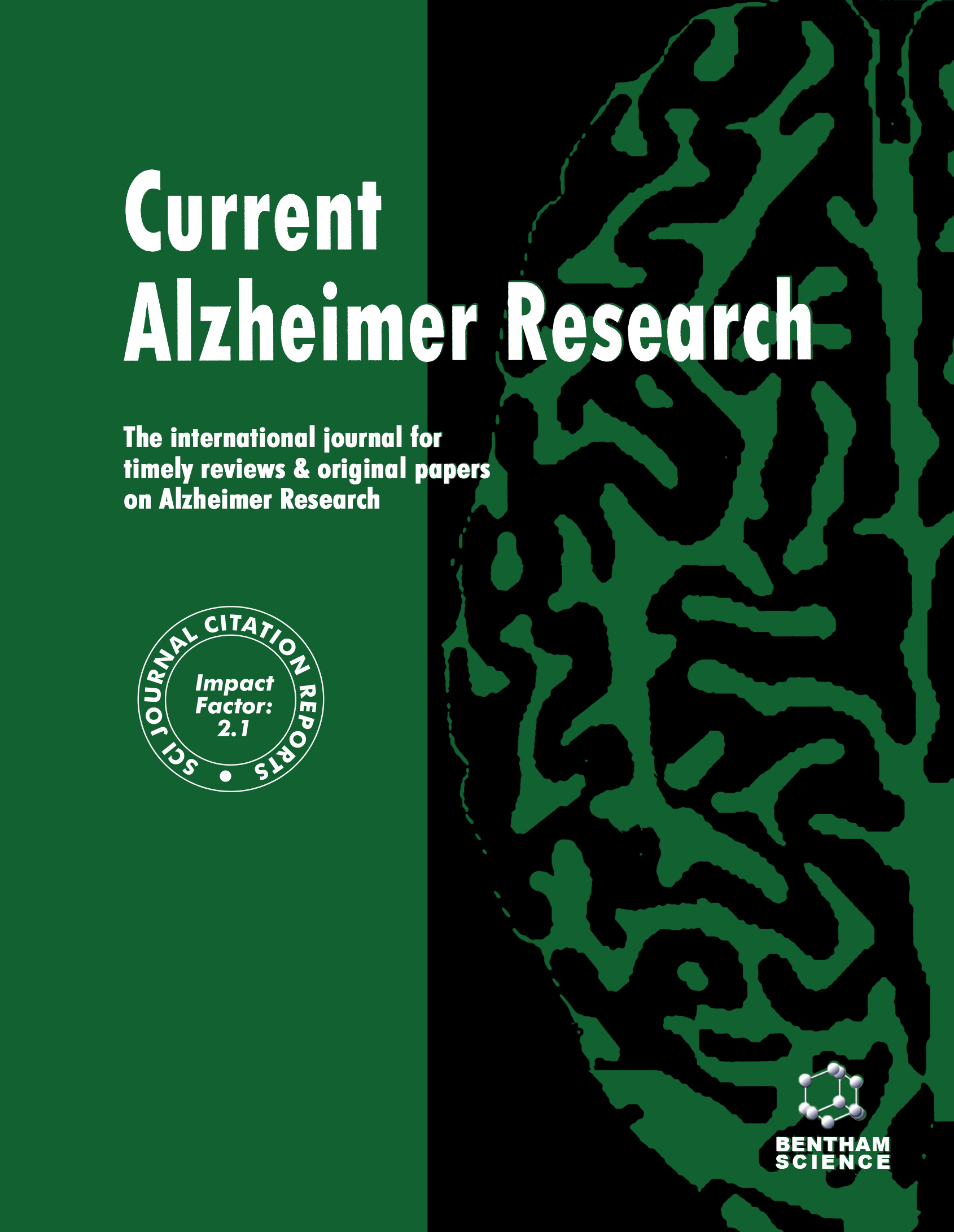- Home
- A-Z Publications
- Current Alzheimer Research
- Previous Issues
- Volume 17, Issue 11, 2020
Current Alzheimer Research - Volume 17, Issue 11, 2020
Volume 17, Issue 11, 2020
-
-
Inflammatory Biomarkers in AD: Implications for Diagnosis
More LessAuthors: Junhyung Kim and Yong-Ku KimAlzheimer’s disease is the most common form of dementia. Due to the lack of effective interventions, early and accurate diagnosis for new interventions are emphasized. However, significant neuronal loss and neuropathological lesions can damage the brain substantially before diagnosis. With our growing knowledge of the role of neuroinflammation in the pathogenesis of Alzheimer’s disease, inflammatory biom Read More
-
-
-
The Association between TNF-alpha, IL-1 alpha and IL-10 with Alzheimer's Disease
More LessBackground: Sporadic Alzheimer’s Disease (AD) is assumed to be associated with different biological/genetic vulnerability, as well as with neuroinflammation, mediated by cytokines. The present study evaluated the role of cytokines in AD. Objective: The aim was to determine the possible association of TNF-α (rs1800629), IL1-α (rs1800587) and IL-10 (rs1800896) polymorphisms with AD, and to assess serum TNF-α Read More
-
-
-
IL-8 and MCP-1 Impact on Tau Phosphorylation and Phosphatase Activity
More LessBackground: Chronic inflammation is a feature of Alzheimer´s disease (AD), resulting in excessive production of inflammatory mediators that can lead to neuroinflammation, contributing to alterations in Aβ production and deposition as Senile Plaques (SPs), and to neurofibrillary tangles (NFTs) formation, due to hyperphosphorylated Tau protein. Objective: This work addressed the impact of the interleukin-8 (IL-8) and monocyte Read More
-
-
-
Electromagnetic Field in Alzheimer’s Disease: A Literature Review of Recent Preclinical and Clinical Studies
More LessAuthors: Reem H.M.A. Ahmad, Marc Fakhoury and Nada LawandAlzheimer’s disease (AD) is a neurodegenerative disorder characterized by the progressive loss of neurons leading to cognitive and memory decay. The main signs of AD include the irregular extracellular accumulation of amyloid-beta (Aβ) protein in the brain and the hyper-phosphorylation of tau protein inside neurons. Changes in Aβ expression or aggregation are considered key factors in the pathophysiology of sporadic and earl Read More
-
-
-
Non-steroidal Anti-inflammatory Drugs as Candidates for the Prevention or Treatment of Alzheimer’s Disease: Do they Still Have a Role?
More LessPurpose of Review: To provide an updated analysis of the possible use of non-steroidal anti-inflammatory drugs (NSAIDs) as treatments for Alzheimer´s disease (AD). Recent Findings: Neuroinflammation in AD is an active field of research, with increasing evidence from basic and clinical studies for an involvement of innate or adaptive immune responses in the pathophysiology of AD. Few clinical trials with anti-inflammato Read More
-
-
-
s Differential Effects of the Interaction Between the Education and APOE 4 Allele on Amyloid-beta Retention and Memory Performances in Cognitively Normal Older Adults and Alzheimer's Disease Patients
More LessAuthors: Dong W. Kang, Sheng-Min Wang, Hae-Ran Na, Chang U. Lee, In-Ho Baek and Hyun K. LimBackground: Despite the effect of education and APOE ε4 allele on amyloid-beta (Aβ) retention and memory, previous studies have not dealt with an interaction between two factors on Aβ deposition and memory function in the course of Alzheimer’s disease (AD). Objective: To evaluate education by APOE ε4 allele interactions for Aβ retention and neuropsychological test scores in cognitively normal older adults without A Read More
-
-
-
Amyloid-beta Induced Neurotoxicity Impairs Cognition and Adult Hippocampal Neurogenesis in a Mouse Model for Alzheimer’s Disease
More LessAuthors: Sanila Amber, Sumera, Fatima J. Mirza, Muhammad Asif, Deeba Hassan, Touqeer Ahmed and Saadia ZahidBackground: Neurogenesis, the key mechanism to generate new neurons from existing stem cell niches continues throughout the life in the adult mammalian brain, although decelerate with aging or the progression of neurodegenerative disorders like Alzheimer’s disease (AD). In the past few years, impaired adult hippocampal neurogenesis emerged as a contributing hallmark of AD pathophysiology along with amyloid beta (A Read More
-
-
-
The Effect of Levosimendan on Two Distinct Rodent Models of Parkinson’s Disease
More LessAuthors: Amjad N. Abuirmeileh, Karem H. Alzoubi and Abeer M. Rababa’hBackground: Parkinson’s disease (PD) is a common neurodegenerative disorder that is characterized by motor symptoms related to the deficiency in dopamine levels, and cognitive symptoms that are similar in nature to those manifested during Alzheimer’s disease. Levosimendan, on the other hand, is a calcium sensitizer and phosphodiesterase inhibitor that was shown to possess neuroprotective, memoryenhancing, and anti-a Read More
-
Volumes & issues
-
Volume 21 (2024)
-
Volume 20 (2023)
-
Volume 19 (2022)
-
Volume 18 (2021)
-
Volume 17 (2020)
-
Volume 16 (2019)
-
Volume 15 (2018)
-
Volume 14 (2017)
-
Volume 13 (2016)
-
Volume 12 (2015)
-
Volume 11 (2014)
-
Volume 10 (2013)
-
Volume 9 (2012)
-
Volume 8 (2011)
-
Volume 7 (2010)
-
Volume 6 (2009)
-
Volume 5 (2008)
-
Volume 4 (2007)
-
Volume 3 (2006)
-
Volume 2 (2005)
-
Volume 1 (2004)
Most Read This Month
Article
content/journals/car
Journal
10
5
false
en

Most Cited Most Cited RSS feed
-
-
Cognitive Reserve in Aging
Authors: A. M. Tucker and Y. Stern
-
- More Less

